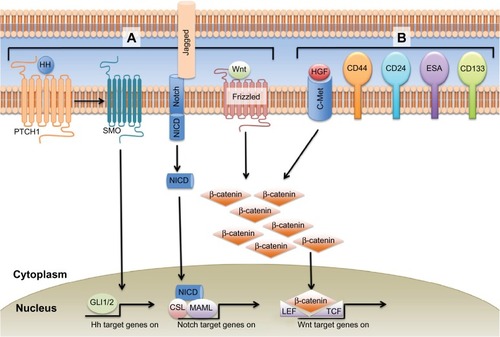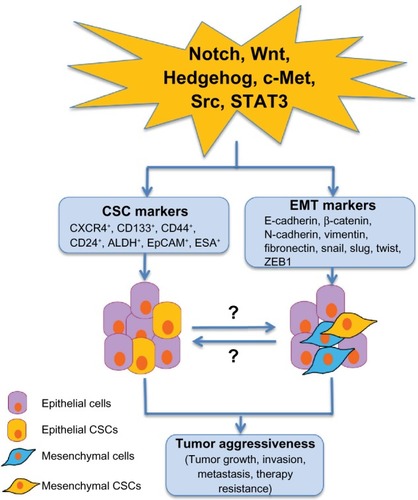Figures & data
Figure 1 EMT signaling pathways and CSC markers in pancreatic cancer.
Notes: (A) Hedgehog, Notch, and Wnt signaling promote EMT, and are also active in pancreatic CSCs. (B) CSC surface markers CD44, CD24, and ESA may promote cell-to-cell interaction. The c-Met tyrosine kinase receptor binds HGF and is a marker of tumorigenicity. The function of CD133 and ALDH (not shown) in CSC regulation is not known.
Abbreviations: ALDH, aldehyde dehydrogenase 1; CSC, cancer stem cell; EMT, epithelial–mesenchymal transition; ESA, epithelial-specific antigen; HGF, hepatocyte growth factor.
Abbreviations: ALDH, aldehyde dehydrogenase 1; CSC, cancer stem cell; EMT, epithelial–mesenchymal transition; ESA, epithelial-specific antigen; HGF, hepatocyte growth factor.

Figure 2 Potential cellular signaling pathways linking to pancreatic CSCs and EMT in tumor aggressiveness.
Notes: The cellular signaling crosstalk and regulation of multiple cellular signaling pathways, including Notch, Wnt, Hedgehog, Src, and STAT3, play critical roles in self-renewal of CSCs, EMT, tumor aggressiveness, metastasis, and therapy resistance. These signaling pathways’ activation drives two critical tumor-promoting pathways: (1) increase in CSC markers and (2) EMT promoting markers. These pathways interact with one another, leading to CSC- and EMT-dependent aggressive tumor type. Therefore, targeting these signaling pathways could eliminate pancreatic CSCs and EMT-type cells, which could lead to better treatment outcomes for patients diagnosed with PDAC.
Abbreviations: CSC, cancer stem cell; EMT, epithelial–mesenchymal transition; STAT3, signal transducer and activator of transcription 3; PDAC, pancreatic ductal adenocarcinoma.
Abbreviations: CSC, cancer stem cell; EMT, epithelial–mesenchymal transition; STAT3, signal transducer and activator of transcription 3; PDAC, pancreatic ductal adenocarcinoma.
